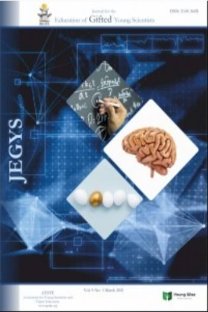The Development of Problem-Based Learning Test Instruments for the High School Physics Problem Solving Skills
Problem solving skills are an important part of physics learning in schools and is also useful for adapting to the environment. Problem solving skills are also a demand for education in the 21st century, so having this skills can help to compete in gaining experience in this all-modern world. This study aimed to determine the feasibility of the developed test instrument in terms of content validity and reliability. The test instrument developed was in the form of multiple choices with a total of 25 questions. The analysis of content validity of the test instrument was conducted using the Aiken's V Coefficient. The empirical validity and reliability of test instrument were estimated using the Classical Test Theory (CTT) and Item Response Theory (IRT). The results of this study showed that the test instrument developed was valid with Aiken's V Coefficient ranging between 0.76 to 0.95 and reliable with a reliability value according to CTT of 9.5, while the developed questions were stated reliable according to the IRT if used by the students with the ability ranging between -1.2 to 3.8 in logit scale. Based on the results of the study, the instrument developed was feasible to be used as an instrument for testing problem solving skills.
Keywords:
validity, reliability test instrument, problem solving skills,
___
- Adams, R. J. & Khoo, S. T. (1996). Quest: The interactive test analysis system version 2.1. Victoria: The Australian Council for Educational Research.
- Aiken, L. R.. (1985). Three coefficients for analyzing the reliability and validity of ratings. Educational and Psychological Measurement, 45.
- Arends, R.I. (2012). Learning to Teach. (9th ed). New York: The McGrow-Hill Companies. Inc.
- Asrofi, M.. 2008. Model Pembelajaran yang Menyenangkan. Retrieved from http://www.fisikanet.lipi.go.id.
- Azwar, S. (2017). Reliabilitas dan Validitas. Yogyakarta: Pustaka Pelajar.
- Balasubramanian K., Jaykumar V., Fukey L.N. (2014). A study on “Student preference towards the use of Edmodo as a learning platform to create responsible learning environment. Procedia- Social and Behavioral Sciences, 144, 416 – 422, https://doi.org/10.1016/j.sbspro.2014.07.311
- Basheer, A., Hugerat, M., Kortam, N., Hofstein, A. (2017). The Effectiveness of Teachers' Use of Demonstrations for Enhancing Students' Understanding of and Attitudes to Learning the Oxidation-Reduction Concept. Eurasia Journal of Mathematics, Science and Technology Education, 13(3), 555-570. https://doi.org/10.12973/eurasia.2017.00632a
- George, D., & Mallery, P. (2003). SPSS for Windows step by step: A simple guide and reference. 11.0 update (4th ed.). Boston: Allyn & Bacon.
- Gunawan, A. Harjono, H. Sahidu1, L. Herayanti. Virtual Laboratory To Improve Students’ Problem-Solving Skills On Electricity Concept. Jurnal Pendidikan IPA Indonesia, 6(2), 257-264. https://doi.org/10.15294/jpii.v6i1.8750
- Hambleton & Swaminathan. (1985). Item Response Theory Principles and Applications. Boston: Kluwer Nijhoff Publishing.
- Hadarah, H, Tulhikmah, R . (2019). Epistemology Philosophy Development of Assessment Instruments Student Chemistry Learning Outcomes. Journal for the Education of Gifted Young Scientists, 7 (3), 627-641. DOI: 10.17478/jegys.605097
- Hedge B., Meera B. N.. (2012). How do they solve it? An insight into the leaner’s approach to the mechanism of physics problem solving. Phisical Review Special Topics – Physics Education Research, 1-9. https://doi.org/10.1103/PhysRevSTPER.8.010109
- Huda, S , Sholikhakh, R , Bina, N , Lestari, F , Habibi, B , Suharso, P . (2019). Effect of Application Smart Circuit Learning Media to Mathematics Learning Outcomes: A Case Study of Islamic School Students. Journal for the Education of Gifted Young Scientists, 7(3), 699-715 . DOI: 10.17478/jegys.597053
- Hwang, G.J., Wu, P.H., &; Chen, C.C. (2012). An Online Game Approach for Improving Students’ Learning Performance in Web-Based Problem Solving Activities. Computers & Education, 59(4), 1246–1256. Retrieved from: https://www.learntechlib.org/p/50289/.
- Khuluqo, I., E. (2016). Belajar dan Pembelajaran. Jakarta: Pustaka Pelajar.
- Kim, J., Ilon, L., Altmann, J. (2013). Adapting smartphone as learning technology in a Korean university. Journal of Integrated Design and Process Science, 17, 5-16. DOI: 10.3233/jid-2013-0002
- Kustyorini, Y. (2012). Pengaruh Pembelajaran Berbasis Masalah Dilengkapi Media Virtual terhadap Aktivitas dan Hasil Belajar Fisika SMA/MA. S2 Tesis, UNY. Retrieved form https://core.ac.uk/download/pdf/11065836.pdf
- Lestari, Fitria & SARYANTONO, Buang & Syazali, Muhamad & Saregar, Antomi & MADIYO, Madiyo & JAUHARIYAH, Durrul & Umam, Rofiqul. (2019). Cooperative Learning Application with the Method of "Network Tree Concept Map":Based on Japanese Learning System Approach, 7, 15-32. 10.17478/jegys.471466.
- Loucks, S. E. (2007). Introductory physics with algebra: Mastering problem-solving. US: John Wiley & Sons.
- Mardapi D. (2012). Pengukuran Penilaian & Evaluasi Pendidikan. Yogyakarta: Nuha Litera.
- Menteri Pendidikan dan Kebudayaan. (2016). Permendikbud Nomor 22 Tahun 2016, tentang Standar Proses Pendidikan Dasar dan Menengah.
- Neubert, J., Mainert, J., Kretzschmar, A., & Greiff, S. (2015). The Assessment of 21st Century Skills in Industrial and Organizational Psychology: Complex and Collaborative Problem Solving. Industrial and Organizational Psychology, 8(2), 238-268. doi:10.1017/iop.2015.14
- Obenchain, K., & Ives, B. (2006). Experiential Education in the Classroom and Academic Outcomes: For Those Who Want it All. Journal of Experiential Education, 29(1), 61–77. https://doi.org/10.1177/105382590602900106
- Polya, G. (1973). How To Solve it. New Jersey: Princeton University Press.
- Ruseffendi. (1991). Pengantar kepada Membantu Guru Mengembangkan Kompetensinya dalam Pengajaran Matematika untuk Meningkatkan CBSA. Bandung, Tarsito.
- Shafa. (2014). Karakteristik Proses Pembelajaran Kurikulum 2013. Artikel: Dinamika Ilmu, 14(1), 81-95.
- Subali, B., & Suyata, P. (2012). Pengembangan Item Tes Konvergen dan Divergen: Penyelidikan Validitasnya secara Empiris. Yogyakarta: Diandra Pustaka Indonesia.
- Supahar, Prasetyo Z. K.. (2015). Pengembangan instrumen penilaian kinerja kemampuan inkuiri peserta didik pada mata pelajaran fisika SMA. Jurnal Penelitian dan Evaluasi
- Pendidikan, 19(1), 96-108. https://doi.org/10.21831/pep.v19i1.4560
- Suryabrata, S. (2002). Pengembangan Alat Ukur Psikologis. Yogyakarta: Andi Offset.
- Başlangıç: 2013
- Yayıncı: Genç Bilge Yayıncılık
Sayıdaki Diğer Makaleler
Suci HARTATİ, Syahfitri PURNAMA, Tati HERİATİ, Endah Kinarya PALUPİ, Arunee KASAYANOND, Roslina ROSLİNA
Winda RAMADİANTİ, Nanang PRİATNA, Kusnandi KUSNANDİ
Gunawan GUNAWAN, Ahmad HARJONO, Lovy HERAYANTİ, Sadam HUSEİN
Antuni WİYARSİ, Nur FİTRİYANA, Jaslin IKHSAN
Ninit ALFİANİKA, Dadang SUNENDAR, Andoyo SASTROMİHARJO, Vismaia S. DAMAİANTİ
Saefuddin SAEFUDDİN, Fahyuddin FAHYUDDİN, Saleh SALEH
Saeful ANAM, İ NYOMAN SUDANA DEGENG, Nurul MURTADHO, Dedi KUSWANDI
Audrey, Evelyn SAPTENNO, Hasan TUAPUTTY, Dominggus RUMAHLATU, Pamella Mercy PAPILAYA
